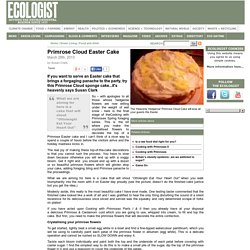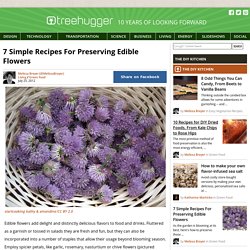

Zoom's Edible Plants. Zoom's Edible Plants The culinary flowers and herbs; beautiful, colorful, scented and … edible!

42 Flowers You Can Eat. The culinary use of flowers dates back thousands of years to the Chinese, Greek and Romans.

Many cultures use flowers in their traditional cooking–think of squash blossoms in Italian food and rose petals in Indian food. Adding flowers to your food can be a nice way to add color, flavor, and a little whimsy. Some are spicy, and some herbacious, while others are floral and fragrant. The range is pretty surprising. It’s not uncommon to see flower petals used in salads, teas, and as garnish for desserts, but they inspire creative uses as well–roll spicy ones (like chive blossoms) into handmade pasta dough, incorporate floral ones into homemade ice cream, pickle flower buds (like nasturtium) to make ersatz capers, use them to make a floral simple syrup for use in lemonade or cocktails. Non-Edible Poisonous Flowers Chart. Recipes - Dandelion Jelly.
Wild Edibles: The Daylily. Disclaimer: Eating certain wild plants can be deadly!!

Be certain to consult a professional (or a really good field guide) in order to positively identify this plant before trying this for yourself. The owners of this site will not be held responsible for any lapses in judgment or stupidity when handling or consuming wild plants. The daylily (hemerocallis fulva) is a very common ornamental plant that has found a home in many yards and gardens throughout the United States. Despite its common occurrence, few realize the year-round food potential of this plant. In this article I’ll go into detail about how to identify, process and eat these delicious plants.
A Story About Edible Daylilies. When I think of Easter, I think of Easter Lilies but now that I’m an edible flower gardener I think of Daylilies for Easter.

One of the reasons I chose to write about our candied Daylilies is because, of all the edible flowers that we grow, I probably get eye-balled the most when I mention that we candy and sell Daylilies and that they really taste like vanilla sugar cookies. Who would have thought of such a crazy idea; eating Daylilies? Cooking With Primroses. These are recipes that reward the lonely forager Primrose Flowers - Where to Look?

Woods, Hedgerows and Grassy Banks Primroses. I can't think of any flower that shouts "Springtime" or Mothering Sunday or Easter more loudly from the hedgerow - making you glad to have survived the long winter doldrums. Now, as I may have mentioned before, I am married to a botanist and so I am required, even in the kitchen, to use the correct latin names for plants. So that's the nomenclature out of the way. After several weeks of forward planning, including trawling old recipe books and online blogs looking for mouth-watering primrose recipes, I came up with almost nothing. No, I need recipes which are delicious in their own right and which happen to include some botanical twist or madness that shouldn't but does work on the palette. Actually, I don't forage alone. Laika is an Australian Kelpie. Cooking With Primroses II. I've come over all delicate - just like the pallor of this delicious floral curd Primrose & Cardomom Curd Like!

Like! Like! This recipe really is a labour of pure love but you will be more than rewarded when you 'dress' the finished jar of primrose curd with its label and whatever cute or fancy fabric you use to decorate the lid. I admit this kitchen adventure was a bit experimental but with a lot of prayer and patience, it worked a treat. Primrose Cloud Easter Cake. What we are aiming for here is a cake that will shout “Ottolenghi Eat Your Heart Out” So – with apologies to all those whose hedgerow flowers are now wilting under the weight of wet snow - here is the final stage of theCooking with Primroses Spring foraging series.

This is the bit where you make the crystallised flowers to decorate the top of a Primrose Easter cake and I can’t think of a nicer way to spend a couple of hours before the visitors arrive and the holiday madness kicks in. The real joy of making these top-of-the-cake decorations is that you cannot rush the process. 53 Rose Petals Recipes - Tarladalal. Cooking with Rose Hips - Rose Hips Recipes. Rose Hips Recipes Rose hips are the cherry-sized red fruits of the rose bush left behind after the bloom has died.

Although nearly all rose bushes produce rose hips, the tastiest for eating purposes come from the Rosa rugosa variety. The flavor is described as fruity and spicy, much like the cranberry. Harvest the fruits after the first frost when they become fully-colored, but not overripe. They should yield to gentle pressure but not be soft or wrinkly. For you gardeners who are lucky enough to have this fruit in your garden, here are some rose hips recipes.
Edible Flowers Tips & Hints. How To Cook With Edible Flowers. Cooking with yummy edible flowers Yes, those flowers look beautiful as garnishes, but what do they taste like?

Bean blossoms have a sweet, beany flavor. Nasturtiums have a wonderfully peppery flavor similar to watercress and their pickled buds can be substituted for more expensive capers. Borage tastes like cucumber, and miniature pansies (Johny-Jump-Ups) have a mild wintergreen taste. Violets, roses and lavender lend a sweet flavor to salads or desserts. Bright yellow calendulas are an economic alternative to expensive saffron, though not quite as pungent.
When in doubt, taste, but first be sure it's not poisonous. 7 Simple Recipes For Preserving Edible Flowers. Startcooking kathy & amandine/CC BY 2.0 Edible flowers add delight and distinctly delicious flavors to food and drinks.

Fluttered as a garnish or tossed in salads they are fresh and fun, but they can also be incorporated into a number of staples that allow their usage beyond blooming season. Employ spicier petals, like garlic, rosemary, nasturtium or chive flowers (pictured above) for savory dishes; use sweeter blooms, like rose, violet, or lemon verbena petals for cocktails and desserts. Cooking With Flowers: Tips & Hints. Edible Flowers Recipes. Edible Flowers Chart. Edible Flowers This chart is a collaborative research project by Amy Barclay de Tolly and Home Cooking Guide Peggy Trowbridge. The links will take you to full color photos of the specific flowers to help with identification, but please don't depend solely on these photos.
Be sure you know exactly what you choose to consume. If you are allergy-prone, it's probably best to forego consumption of flowers. Edible Flower Recipes - Cooking with Flowers.